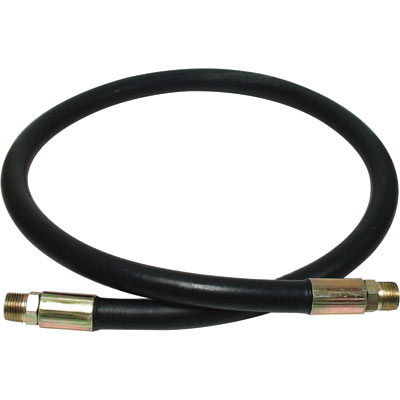Hydraulic Hose
Overview
A hydraulic hose is a high-pressure, synthetic rubber, thermoplastic or Teflon reinforced hose that carries fluid to transmit force within hydraulic machinery.
Details
Hydraulic machinery began to be used in the early 1940s when engineers discovered that hydraulic systems were more compact, lighter in weight and self-lubricating. World War II spurred development of hydraulic machinery for military applications. The development of flexible hydraulic hoses further opened the way for development of a wide array of new, high-powered machines based on hydraulic technology.
Construction Hydraulic hoses are made in three basic parts. An inner tube carries the fluid. It is reinforced with a sheath of braided wire, spiral wound wire or a textile based yarn. A third protective outer layer provides protection from weather, abrasion or oil or chemicals. Hydraulic hoses are designed or custom-made specifically for use in specific mechanical applications. In most cases hydraulic hoses are designed to be specific sizes, lengths and have custom connectors to work in specific machines.
Lifespan Hydraulic hoses are not permanent. A variety of factors can impact the lifespan of a hydraulic hose. Flexing the hose too much, twisting it, kinking, stretching, crushing or scratching the surface can reduce hose life. Too low or too high operating temperatures will break down hoses as will sudden sharp rises or drops in internal pressures. Using the wrong size, type or weight of hoses can also cause hoses to break down. Hoses should be replaced before they fail, especially with hydraulic heavy machinery, brakes or safety critical hydraulic machinery. Hoses show swelling, cracking, blisters and bubbles when worn or may show virtually no signs at all. Replace hoses as often as recommended by the manufacturer to prevent accidents.
Purpose Hydraulic systems have the ability to multiply torque or apply force in a simple way. Mechanical systems would require an intricate system of gears, chains, pulleys and levers, to move machinery at a distance from the engine. Hydraulic systems, however, can transmit force from a force engine to the place where it needs to be in order to do the work simply by stringing hydraulic hoses between the two. Fluids transmit force effectively because they do not compress. The force that is applied at one end of a hydraulic hose travels to the opposite end of the hose with little loss of power. Changes in size of hoses along the way can increase or decrease the force applied at the opposite end.
Advantages Hydraulic hoses can turn forces from a few ounces of pressure into hundreds of tons of output. Using hydraulic hoses, hydraulic machines can create very powerful low speed torque and manage speed and movement of machines with extreme accuracy. A single hydraulic pump or compressor can, through hydraulic hoses power many different machines and machine functions at widely varying power levels at the same time. Hydraulic powered machines can operate safely in areas where there are flammable vapors and electrical or electronic devices could set off explosions.
Hose Ratings Every hose has specific ratings for specific types of fluid they are designed to carry, working temperature ranges and pressure limits for that specific hose. Usually they are printed on the hose or fittings. In some case they print a model number on the hose and provide a spec sheet for the various models.
Caution Hydraulic systems operate under high pressure to drive machinery. Hoses that fail at high pressures can whip about with extreme violence and injure bystanders or machine operators. Hydraulic hoses should be checked and replaced according to manufacturers recommendations.
Product Ecology
Made with
Uses
Powers
Fabrication
